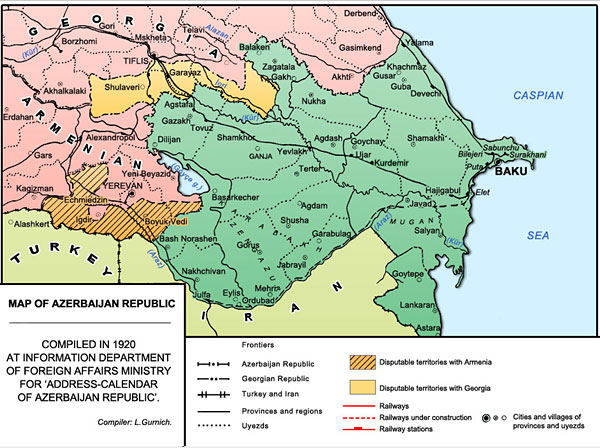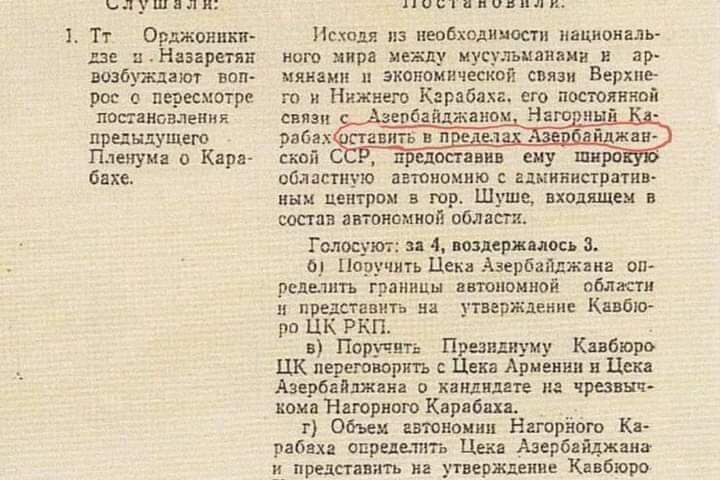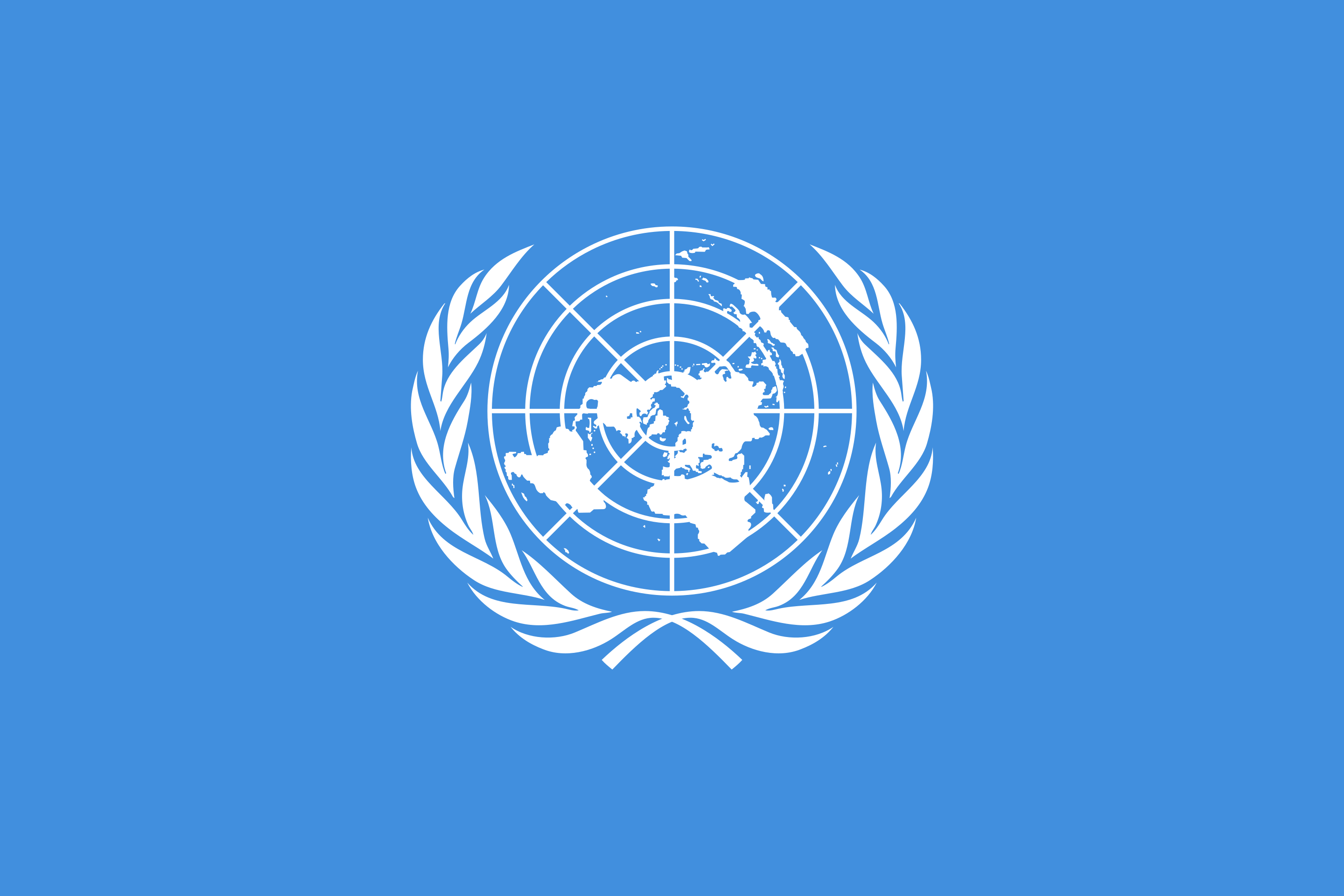The well-known session of the Caucasus Bureau of the Central Committee of the RKP(b) on June 27, 1921 adopted a statute about the objectively existing economic linkage of Nagorno-Karabakh to Azerbaijan, while leaving the historical and ethnographic factors aside. However, a week later, on July 4, the next session of the Caucasus Bureau of the Central Committee of the RKP(b), one held with Stalin’s participation, featured another voting in which S. Kirov, the future leader of the party organization of Azerbaijan (three weeks later he became secretary of the Central Committee of the KP(b) of Azerbaijan), and G. Ordzhonikidze who directly controlled the Trans-Caucasus republics, voted “in favor of” the resolution which said “to include Nagorno-Karabakh in the Armenian SSR and to conduct a plebiscite only in Nagorno-Karabakh.” [1]
Among those who took part in the work of that plenum were: Stalin, a member of the Central Committee of the RKP(b); Ordzhonikidze, Makharadze, Narimanov, Myasnikov, Kirov, Nazaretyan, Orakhelashvili, and Figatner, all of the latter being members of the Caucasus Bureau of the Central Committee of the RKP(b); Bretiman, the secretary of the Caucasus Bureau RKP(b) Komsomol; as well as Tsintsadze, Mdivani and Svanidze, members of the Central Committee of the KP(b) of Georgia. Two different perspectives were voiced during the session in the course of discussions over the Nagprno-Karabakh issue and the following questions were put to a vote: a) to keep Karabakh within the borders of Azerbaijan (those voting in favor were Narimanov, Makharadze, and Nazaretyan; those opposed: Ordzhonikidze, Myasnikov, Kirov, and Figatner); b) to conduct a plebiscite throughout Karabakh with the participation of the entire population of Armenians and Muslims (those voting for: Narimanov and Makharadze); c) to include the mountainous part of Karabakh (Nagorno-Karabakh, that is) within Armenia (those voting for: Ordzhonikidze, Myasnikov, Figatner, and Kirov), and d) to conduct a plebiscite only in Nagorno-Karabakh (those voting for: Ordzhonikidze, Myasnikov, Figatner, Kirov, and Nazaretyan). [2]
There is a note in the protocol indicating that during the voting on the question of Nagorno-Karabakh, Comrade Orakhelashvili was absent. This seems to have been a more honest approach than the one adopted by S. Kirov—then the most likely candidate to assume leadership of the party organization of Azerbaijan—and G. Ordzhonikidze—who had previously written to Lenin and Chicherin numerous times with appeals to retain both the mountainous and lowland portions of Karabakh in Azerbaijan—both of whom now voted for the inclusion of Nagorno-Karabakh within Armenia, an act which in the first instance compromised the territorial integrity of Azerbaijan.
An interesting question arises here: Why would G. Ordzhonikidze and S. Kirov, who had both only a few months earlier insisted in the preservation of Nagorno-Karabakh within Azerbaijan—because “they could not imagine Azerbaijan without Karabakh”—now, beginning in June and July 1921, changed their opinion in a fundamental way? Were both of them, as trusted representatives of Moscow in the South Caucasus, fulfilling a secret directive from the Center by simultaneously voting against Azerbaijan at the plenum of the Caucasus Bureau of the Central Committee of the RKP(b) on July 4? Indeed, the transformation of Nagorno-Karabakh in June-July 1921 into an object of secret—and shortly afterwards open—discussions of the Caucasus Bureau of the Central Committee of the RKP(b) and the efforts to forcibly hand over Nagorno-Karabakh were connected with the conclusion—on March 16, 1921—of the Moscow Treaty between Soviet Russia and Kemalist Turkey, the latter document featuring a clause specifying that the Nakhchivan oblast is formed as an autonomous territory under the protectorate of Azerbaijan with the condition that Azerbaijan not concede its protectorate to a third state.
The text and the political meaning of the decision of the Caucasus Bureau of the Central Committee of the RKP(b) were subjected to varied readings and even falsifications from the very first day of its adoption on July 4, 1921. What happened was that Armenian authors replaced the verb “include” in the text with the verb “leave.” N. Narimanov’s statement calling for transferring consideration of the Nagorno-Karabakh question to a final decision of the Central Committee of the RKP(b) put a fait accompli before the participants of the session. To be precise, he said the following: “In view of the importance, which the Karabakh question has for Azerbaijan, I consider it necessary to transfer it for final decision to the Central Committee of the RKP.” Only thanks to the sharp protest of Narimanov, the wording of the final decision that the assembly adopted came to be as follows: “In view of the fact that the question about Karabakh has called for a serious disagreement, the Caucasus Bureau of the Central Committee considers it necessary to transfer it for a final decision to the Central Committee of the RKP.” [3]
As we can see, one and the same session featured the discussion over the Karabakh question under the fifth point, followed by the discussion—under the sixth point—of Narimanov’s statement concerning the fifth point of the plenum’s decision about that question. That is, the decision taken on the sixth point superseded the results of the previous voting. One way or the other, a majority of the participants of the plenum voted for the decision called for by N. Narimanov. Subsequently, however, this issue was not transferred to discussion in the Central Committee of the RKP(b) in the first instance, because G. Ordzhonikidze decided to retreat from his mistaken position and along with A. Nazaretyan a day later raised the question about the review of the decision of the previous plenum about Karabakh. [4]
On July 5, the plenum of the Caucasus Bureau of the RKP(b) continued its work. As noted, during that session, G. Ordzhonikidze and A. Nazaretyan raised the question about the review of the decision of the previous plenum about Karabakh. Following the discussions, the plenum decided: “a) in view of the need for national peace between Muslims and Armenians and the economic ties of Upper and Lower Karabakh and its continuing linkages with Azerbaijan, to keep Nagorno-Karabakh within the borders of the Azerbaijan SSR and give it broad oblast autonomy with its administrative center in the city of Shusha located within the borders of the autonomous oblast. Four attendees vote in favor; three abstain; b) to assign the Central Committee of Azerbaijan to define the borders of the autonomous oblast and to present them for confirmation by the Caucasus Bureau of the Central Committee of the RKP; c) to assign to the Presidium of the Caucasus Bureau of the Central Committee to negotiate with the Central Committee of Armenia and the Central Committee of Azerbaijan about a candidate for the role of the extraordinary comissar of Nagorno-Karabakh; d) to have the Central Committee of Azerbaijan define the extent of the autonomy of Nagorno-Karabakh and to present this for confirmation to the Caucasus Bureau of the Central Committee.” [5]
The Armenian side tries to connect the fact of the replacement of the first “just decision” about the transfer of Nagorno-Karabakh to Armenia with the “unexpected” arrival in Tiflis of I. Stalin, who—they argue—must have offered protection to Azerbaijan in his own unique manner. We, however, know that Stalin had been in Tiflis since the end of June and could not therefore “unexpectedly” come to the plenum of the Caucasus Bureau of the Central Committee of the RKP(b) on July 5. Why then do Armenian historians, when falsifying the well-known documents of the Caucasus Bureau of the Central Committee of the RKP(b), ascribe primarily to Stalin “the leaving” (“the transfer,” according to the Armenian treatment of the term) of Nagorno-Karabakh within the confines of Azerbaijan? The answer is simple: given the background of the revelation of new Stalinist crimes during the period of the collapse of the USSR, the Armenians wanted to profitably present themselves to the entire world as victims of the Stalinist regime and in this way, by eliciting pity, to demand the restoration of what they understand to be historical justice.
Notes
[1] Protocol No. 11 of the evening session for the Plenum of the Caucasus Bureau of the Central Committee of the RKP(b), 4 July 1921, Russian State Archive of Social-Political History (hereafter RSASPH), f. 64, op. 1, d. 1, l. 118.
[2] Protocol No. 11 of the evening session for the Plenum of the Caucasus Bureau of the Central Committee of the RKP(b), 4 July 1921, Russian State Archive of Social-Political History (hereafter RSASPH), f. 64, op. 1, d. 1, l. 118.
[3] Protocol No. 11 of the evening session of the Caucasus Bureau of the Central Committee of the RKP, 4 July 1921, RSASPH, f. 64, op. 1, d. 1, l. 114.
[4] Protocol No. 12 of the session of the plenum of the Caucasus Bureau of the Central Committee of the RKP, 5 July 1921, RSASPH, f. 64, op. 1, d. 1, l. 122.
[5] Protocol No. 12 of the session of the plenum of the Caucasus Bureau of the Central Committee of the RKP, 5 July 1921, RSASPH, f. 64, op. 1, d. 1, l. 122.







